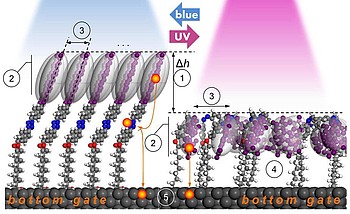Optically Reconfigurable Nanoscale Junctions for Organic Electronics

In order to impart a light responsive nature to the organic electronics device, small molecules called photochromes should be structurally embedded into the organic semiconducting materials. In such hybrids, light stimulus modulates the properties of photochromes, which affects the whole system since photochromic molecules and a semiconductor are coupled. In such a way, light switches and controls the fundamental physicochemical properties of a semiconductor. The long-term goal is to devise a systematic multiscale simulation approach which will shed new light on the mechanisms behind the optical reconfigurations of the two-terminal junctions consisting of azobenzene photochromes self-assembled in a monolayer at the bottom electrode coupled either to the layer of organic semiconductor or to the top flexible electrode. By combining such building blocks, one can achieve the light-controlled reversible changes in both the geometrical structure and the charge transport properties of the entire junction. The outcomes of this project (PI Vladyslav Savchenko) will complement the development of new approaches enabling charge transfer processes at the hybrid interfaces to be precisely controlled by a light stimulus. Moreover, the study of the junctions with a flexible top electrode will further advance the fabrication of the shape-changeable actuators.
Total optical reconfiguration of the conjugated phase (here bithiophene shown as ellipsoids) chemically bound to the azobenzene molecules in the SAM is shown in Figure. The thickness of the layer Δh (1), the packing (2) and conjugation pattern (3), the conformation of the linker (4) are influenced by light. The azo SAM can enable the optimisation of the charge trapping (orange bead on trans-azo bond) and extraction (5).
For more details see here

